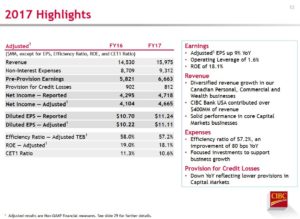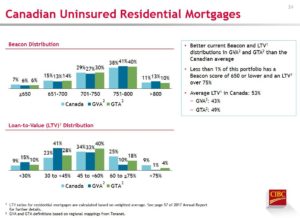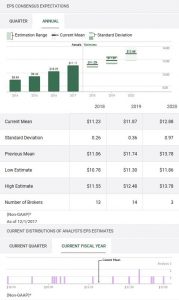Contents
 Summary
Summary
- While CM recently reported solid FY2017 results, its higher exposure to the heavily indebted Canadian consumer relative to its peers does make it more vulnerable to an economic slowdown.
- PAA Research in the US recently released a report suggesting that CM faces headwinds which will likely result in a 30 – 40% pullback in its stock price.
- CM’s senior management is well aware of its risks, and therefore, is in the process of diversifying its business into the US. Growth targets for its US business suggest another US acquisition will be required.
- A retracement in stock price to the magnitude suggested by PAA is highly improbable. An investment in CM should be approached from the perspective of it being a long-term investment.
All figures are expressed in Canadian dollars.
Introduction
Prior to reading this analysis on The Canadian Imperial Bank of Commerce (TSX: CM), you are encouraged to read my recent analysis on The Royal Bank of Canada (TSX: RY).
Recently PAA Research (“PAA”) based in Atlanta, Georgia released a report suggesting investors are being presented with an opportunity to profit by shorting (please listen to video) the Canadian banks and in particular, RY and CM.
The founder of PAA lays out his case for shorting the Canadian banks within the first 3 minutes of the video. He then elaborates on his rationale for his “short” call in the remainder of the ~11 minute video.
In my RY post I present my take on why shorting the Canadian banks stocks is not a recommended course of action.
Q4 2017 and FY2017 Results
CM is scheduled to hold its Investor Day on December 13, 2017 wherein investors and analysts will be provided with an update on the bank’s growth strategy. Until such time, however, readers may wish to review the condensed FY2016 and FY2017 results. In addition, a detailed Q4 and FY2017 results presentation can be found here with supplementary detailed information available here.


 Source: CM’s FY2017 and Q4 Results
Source: CM’s FY2017 and Q4 Results
FY2018 Outlook
CM is the major Canadian financial institution with the most exposure to the Canadian consumer and housing market; roughly 60% of its income is derived from Canadian personal and commercial banking versus peer levels between 30% – 50%. Given this and the headwinds I outlined in my RY post this makes CM more vulnerable to a real estate market correction, the overly indebted Canadian consumer, and a downturn in the Canadian economy.
Readers must understand, however, that CM does not operate in a vacuum. Senior management is keenly aware of the risks it faces. In an effort to reduce its vulnerabilities and in an effort to enhance its ability to serve its Canadian customers who conduct business in the US, it acquired Chicago-based PrivateBancorp in June 2017 for ~CDN$5B; this bank has recently been rebranded CIBC Bank USA.
The final purchase price certainly was well in excess of CM’s original intent to make an acquisition in the $1B – $2B range. Considering the bank it acquired has a relatively small presence in the US with only 34 offices in 12 states, it will certainly be an uphill battle to attain management’s stated objective of generating 25% of bank-wide profits from its new US division by 2024.
Victor Dodig, CM’s President & CEO has certainly made progress in improving CM’s performance since taking the helm in September 2014. This, however, has largely been achieved on the basis of cost cutting which is extremely different from hitting targets on the basis of revenue growth.
Given the ~5% annual EPS growth target and the goal to generate ~25% of CM’s profits from its new US division by 2024, I am of the opinion that another US acquisition will need to occur. Based on the US expansion experiences of The Toronto-Dominion Bank (TSX: TD), The Royal Bank of Canada (TSX: RY), and The Bank of Montreal (TSX: BMO), organic growth is not easy to achieve in the saturated US market. I think CM is well aware of this and I strongly suspect CM will make further US acquisitions once it has had a chance to properly integrate its recent acquisition.
While CM is definitely more vulnerable than its larger Canadian counterparts and its stock price will probably experience some pullback I do not envision the dramatic price drop postulated by PAA.
Dividends, Dividend Yield, and Dividend Payout Ratio
CM’s dividend history can be found here.
As with the other major Canadian financial institutions, CM froze its quarterly dividend during the Financial Crisis. It also froze its quarterly dividend in the late 1990s.
Prior to the Financial Crisis, CM would set its quarterly dividend once a year. Subsequent to the Financial Crisis, CM’s quarterly dividend has been increased on a more frequent basis.
The current quarterly $1.30 dividend results in a 4.40% dividend yield based on the December 1, 2017 closing stock price of $121.20. If CM continues with its practice of increasing its quarterly dividend on a more frequent basis, however, the forward dividend yield will be slightly in excess of that reported on stock screeners.
Readers should also take into consideration that CM’s stock price has appreciated ~$17/share within a span of 3 months. This is a fairly rapid increase within a short timeframe and a pullback in the stock price is not out of the realm of possibility. Even if one does not occur, the current dividend yield is still attractive.
CM’s adjusted dividend payout ratio as at October 31, 2017 was 46.1%. If, however, the results of CIBC Bank USA (acquisition completed June 23, 2017) are included in the U.S. Commercial Banking and Wealth Management strategic business unit figures, the adjusted dividend payout ratio increases marginally to 46.2%. This payout ratio is comparable to recent historical levels.
Valuation
The current mean FY2018 adjusted EPS estimate from various brokers is $11.23 with a very significant disparity in estimates.
Using the low ($10.78), mean ($11.23), and high ($11.55) adjusted EPS estimates and the current $121.20 stock price I get a forward adjusted PE of ~11.24, ~10.79, and ~10.49. Readers who have read my RY post will note that CM’s valuation levels are lower than those of RY (~12.94, ~12.57, and ~12.14). RY, however, has a superior franchise to that of CM which, in my opinion, explains why investors are willing to pay more on an adjusted PE basis for RY.
Final Thoughts
CM has on many occasions been viewed by investors as the least attractive of the Big 5 Canadian banks. The reasoning for this is that it is far more exposed to the Canadian economy and consumer than its 4 larger peers; they all are more geographically diversified and have more diversified streams of income.
CM took a hit as a result of its acquisition of PrivateBancorp that was far in excess of the price it originally intended to pay. Secondly, the issuance of new equity for this acquisition diluted EPS. I am of the opinion, however, these drawbacks are already priced into CM’s current stock price.
In a recent interview, David Dodge, senior advisor at Bennett Jones and former Bank of Canada governor, stated that investors looking to make money betting against the Canadian banks have typically lost money on this decision.
There certainly is the potential to make money by betting on a pullback in CM’s stock price and this strategy might be suitable depending on your investor profile. As for me, I do not get overly concerned about the gyrations in the stock prices of the major Canadian financial institutions. I merely follow a buy, hold, and reinvest the dividends strategy which has worked extremely well over the years.
I wish you much success on your journey to financial freedom.
Thanks for reading!
Note: I sincerely appreciate the time you took to read this post. As always, please leave any feedback and questions you may have in the “Contact Me Here” section to the right.
Disclaimer: I have no knowledge of your individual circumstances and am not providing individualized advice or recommendations. I encourage you not to make any investment decision without conducting your own research and due diligence. You should also consult your financial advisor about your specific situation.
Disclosure: I am long CM, RY, TD, and BMO.
I wrote this article myself and it expresses my own opinions. I am not receiving compensation for it and have no business relationship with any company whose stock is mentioned in this article.
My Amazon picks.


